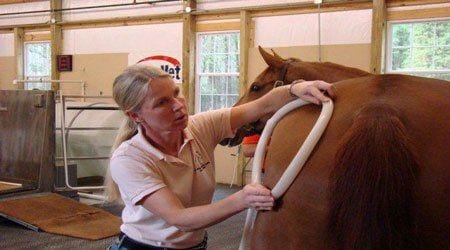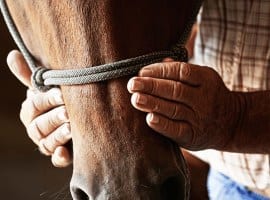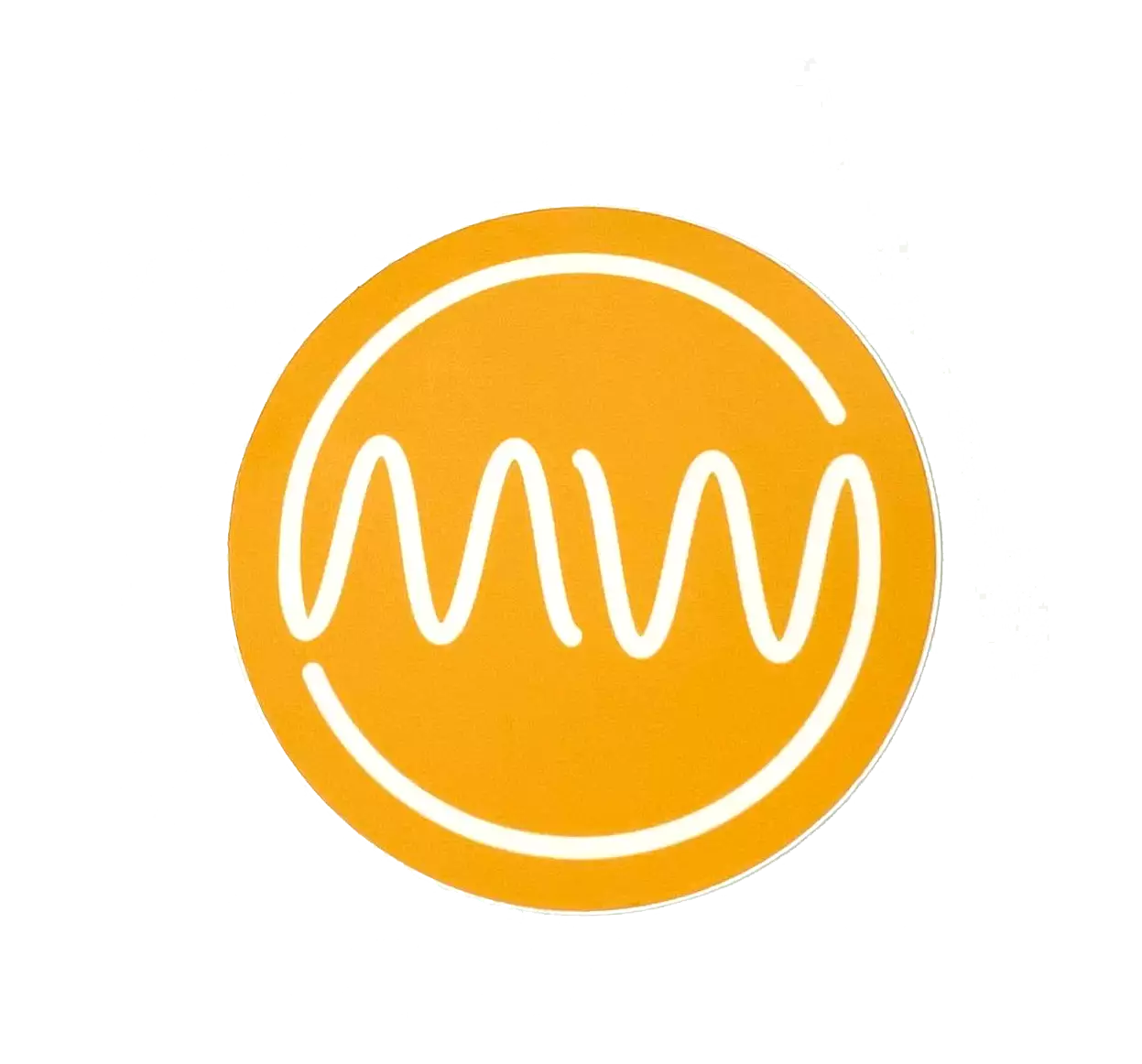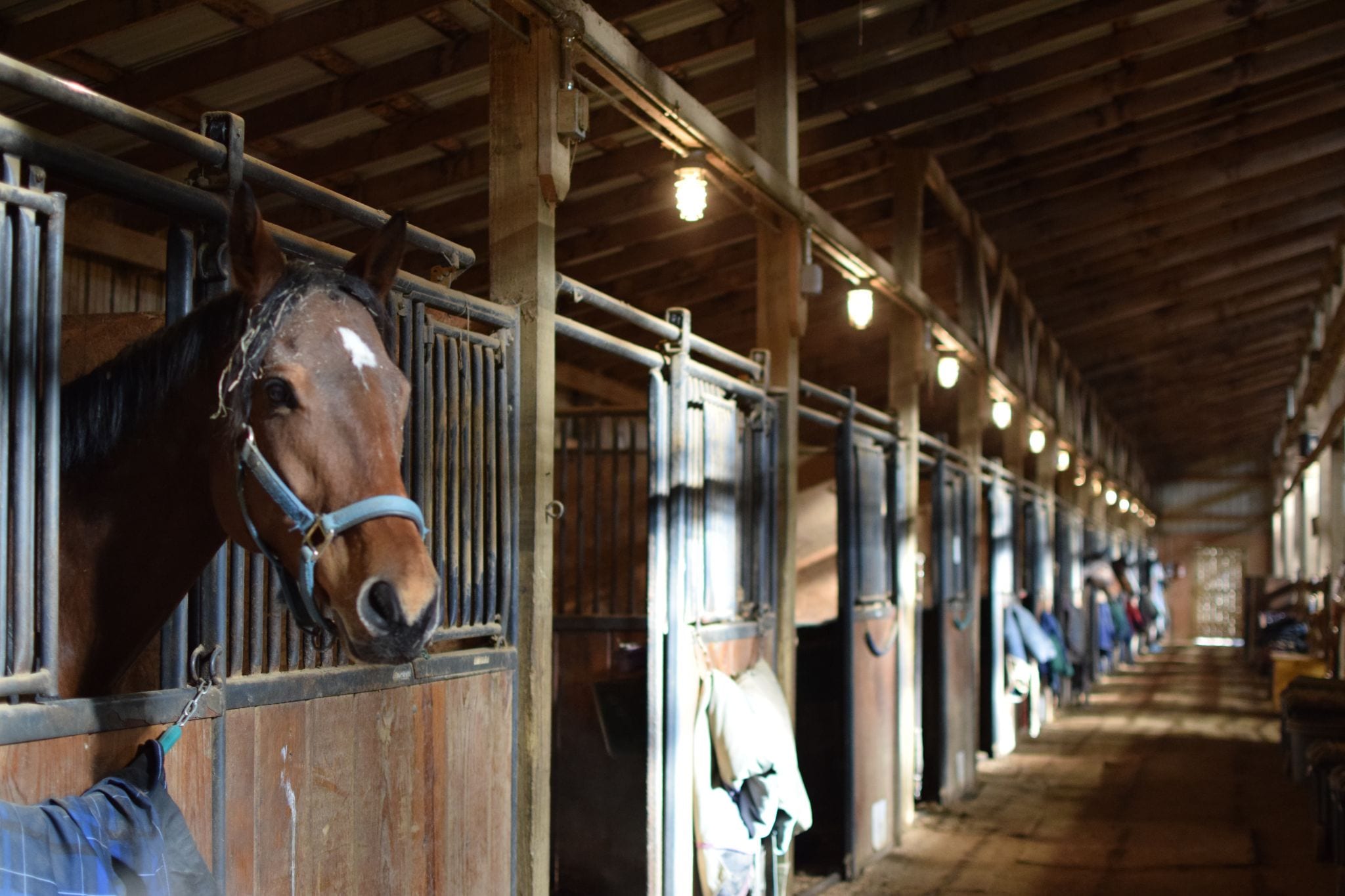EPM is one of the most difficult to pinpoint and progressively debilitating neurologic diseases to strike the horses we love. by LA Pomeroy
When it savages the central nervous system, it leaves behind gait abnormalities, ataxia (inability to control voluntary muscle movement) limb spasticity, sore backs, locked stifles, and muscle atrophy. If it attacks the brain stem, the results are depression, behavioral changes, facial nerve and/or tongue paralysis, roaring, vision problems, drooping eyelids, and difficulty swallowing. Left unchecked, it will take a horse’s life.
“It” is equine protozoal myeloencephalitis, or EPM, and in the United States, the number of horses who test positive after exposure to it varies from 5% or less among wild herds in Montana and Wyoming to 50% or more among backyard barns and professional show stables abutting the natural habitat of opossums. Yes, opossums have been identified as a vector (transmitter of disease) for EPM. But this “enigmatic infection,” as the UC Davis Center for Equine Health calls it, is more complicated.

Clinical researchers Chinedu Njoku, William Saville, and Stephen Reed, who have looked at how reduced levels of nitric oxide metabolites in cerebrospinal fluid are associated with EPM, observe: “EPM is the most prevalent cause of neurologic disease in horses in the Americas. In some parts of the US over 30% of horses have antibodies to Sarcocystis neurona (the most common protozoan parasite causing EPM infection), although a much smaller percentage develop clinical EPM, indicating that additional factors, which we do not yet understand, contribute to the onset of this disease.”
Alternative equine care practitioners who say they have been treating EPM symptoms in racehorses and performance horses for decades are also looking at some of those “additional factors,” and arriving at some bold new conclusions that may help take aim at a disease that has staunchly remained a moving target.
STATISTICS SHOW…
According to EPM expert Robert MacKay, BVSc, PhD, DACVIM, roughly 60% of horses who get an active infection will respond to drug treatment, with 10% recovering fully.
“That leaves 40% of cases in declining health, usually ending in death,” MacKay notes. “The better news is that, if diagnosed and treated early, the statistics rise to 80% responding well to treatment, with many recovering fully. You, the owner, can make the difference in where your horse falls in the statistics by learning prevention and how to identify symptoms of EPM before it strikes.”
Because 30% to 60% of horses in North America have antibodies to the primary protozoal parasite responsible for EPM, S. neurona, UC Davis researchers call EPM inherently difficult to diagnose: “At present, definitive diagnosis of EPM relies on post-mortem examination of neural tissue. No test in the live horse is currently considered definitive.”
One opinion says it’s the owner’s responsibility to diagnose EPM early; another says the only way to confirm it is after death. What’s a horse owner to do?
Plenty.
ACUPUNCTURE: GOOD VIBRATIONS
Dianne Volz has dedicated more than 20 years to using acupuncture points, electric muscle stimulation, ultra- and infra-sound, and laser and photon therapy to listen to the equine immune system and respond accordingly. Her mentor has been Dr. Marvin Cain, founder of the Equine Acupuncture Society of America, who is credited with identifying acupuncture’s EPM immune points, and has suggested a link between suppression of the immune system and EPM.
“Eighty percent of horses we look at are in some stage of EPM,” she says. “Those who don’t have a strong immune system are in greatest need of a defense against the protozoa.”
In Chinese acupuncture, diagnostic points are called “Au Shi” and are sensitive during periods of illness, when the body’s electrical systems are disrupted. Blockages of energy or Qi (pronounced ‘Chi’) cause buildups in inappropriate places (much like a tree falling across a stream blocks the water, flooding areas nearby). When an aggravating condition in the body is resolved (the “tree” removed), Au Shi points ebb away, too.
Volz identifies EPM acupuncture points as located in a triangle over the rib cage, hip, hind leg, and shoulder. “When these points are reactive, we find soreness, hock tenderness, and a tendency to shift weight to the forehand. Therapeutically, we look at the whole body, but we tend to see EPM expressed in the right hind leg.”
This right-sided affliction is important, since EPM mirrors other neurological diseases including Wobbler Syndrome, Equine Herpes Virus (EHV-1), or Lyme Disease. Dr. Cain has observed that soreness or lameness expressed in the left hind tends to lead to a diagnosis of EHV-1; signs in the right hind are more likely attributed to EPM.
Pocono Downs Race Track veterinarian, Dr. David Sachs, who uses acupuncture and acupressure on its racehorses, also sees problems in the right hind trace back to EPM. He thinks EPM has reached “nearly epidemic” proportions and for young racehorses following a circuit, without time off to rest and rebuild their immune system, recovery is difficult.
BLOOD SAMPLE
“Without three to four weeks off, a racehorse can’t bounce back,” Dr. Sachs says. He prefers avoiding corticosteroids (“It bothers the immune response”), and has seen his best results over the last three years treating EPM with kinesiology and injecting “hot” points with the patient’s own blood.
The theory behind blood injections is that, through spinning the blood in a centrifuge, red blood cells are removed, and the remaining platelets (containing helpful hormones and proteins) de-granulate, so they can be injected more “cleanly” back into receptors in the horse’s body.
Lindsay McLean, an acupuncturist who also identifies EPM by what she calls “Environmental Illness” points, says horses get “very beneficial effects when blood is injected. It is especially helpful for depressed states, chronic fatigue, and autoimmune disorders.”
Dr. Sachs emphasizes that the degree of success depends on where in the EPM cycle the treatment begins. He has had “good results” when injecting sites two to three times per week. “Check the points to see if they are hot, and if necessary, inject again.”
Gary and Michaela Young opened Camden Equine Rehabilitation and Conditioning Center in Camden, South Carolina, earlier in 2010 to offer alternative sports medicine and veterinary technology for equine injury recovery, post-surgical care, and accelerated conditioning.
“We started with Dr. Cain a long time ago,” Gary Young says. “Along with our vet, Dr. Sam Tetterton, we have probably brought more horses back from EPM than just about any stable in the country. We have been treating it for over 25 years.”
Like Dr. Cain, Young has discovered markers for EPM on the hindquarters, with signs arising in the right stifle first, and in immune points in the shoulder. One test he uses to determine if a horse is EPM-positive is to blindfold the animal and see if it can walk a straight line. “Since EPM can affect the brain stem and coordination, they can’t walk straight.”
IMMUNE TO HARM
Young calls EPM the single most misdiagnosed equine disease in America today: “In the 1960s my parents believed horses who showed ‘Wobbles’ were showing the first signs of EPM. The parasite has since changed and evolved.” He cites how blood tests identify two protozoa (S. neurona, and less commonly, Neospora hughesi), but who’s to say we are not missing others?
A strong immune system is the first line of healthy defense.
“Stress and/or a weakened immune system can cause relapses,” Young says. He often suggests administering an ulcer-prevention drug prior to shipping, to lower the chance of relapse, since “parasites love ulcers.”
Young owns a horse with EPM, and his personal strategy is low-stress, low-impact therapy. “Aquatherapy – working on a treadmill in water – keeps muscles conditioned while minimizing stress.”
He also uses Pulsed Electro-Magnetic Field (PEMF) MaganWave to stimulate cell metabolism and tone down “hot” nerves: “Cell protein synthesis is enhanced, which allows the body to take advantage of all the protein available. Circulation is improved, not by increasing heartbeat or blood pressure, but by opening and dilating arteries and capillaries, and the lymphatic system is stimulated, to clean damaged areas and detoxify the body.”
Young and Volz both use Chinese herbs to help boost the immune system. “Twice a year, I ‘clean out’ their systems with Chinese herb supplements,” Young says. “I also supplement before shipping. Even if my horse is ‘clean’ at home, shipping can cause a relapse so I keep them on supplements while at a show and for several days after coming home.”
Volz sees herb supplements as conducive to restoring nerve endings, boosting the immune system, and easing gastric ulcers. She agrees that protozoa love ulcers, where holes in the stomach lining allow entrance into a horse’s bloodstream. Among her favorite “protozoa killers” is the hardy American herb, artemsia, related to the daisy family, Asteraceae.
EPM: THE NEXT GENERATION
“We have become more aware” of EPM, Volz says. And more open-minded to the use of Chinese herbs or blood injections, and to earlier diagnoses through acupuncture points.
“EPM is a battle,” acknowledges Gary Young, “but don’t panic. It is manageable and you and your horse can learn to live with it.”
Young concludes, “If your veterinarian is not trained in Eastern medicine, i.e. acupuncture, Chinese herbs, etc., they might miss the early warning signs, but even the top ‘traditional medicine’ vets are starting to believe they can learn more about this disease by keeping an open mind to alternative medicine, which can minimize the dependency on drugs, save money, and ultimately and most importantly, save the horse.”
L.A. Pomeroy of Northampton MA is an equestrian photojournalist and award-winning publicist. A member of American Horse Publications since 1992, she is a prolific participant in the horse care realm. She enjoys trail riding in her native Catskill Mountains of upstate New York, and collecting/researching equestrian art and collectibles. Follow LA on Facebook and read her blog at HolisticHorse.com


